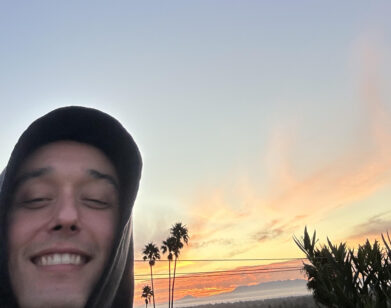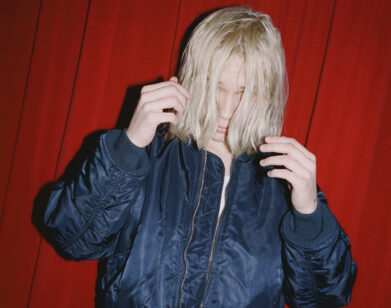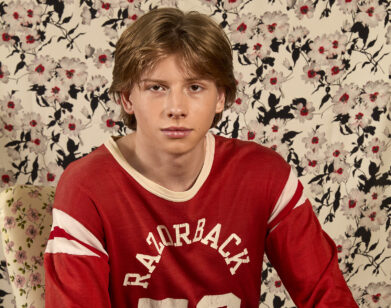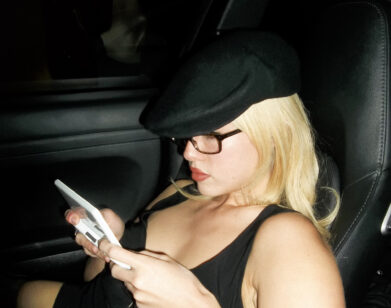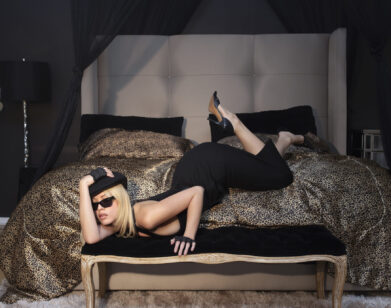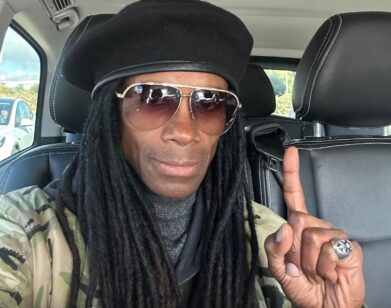Discovery: Morly
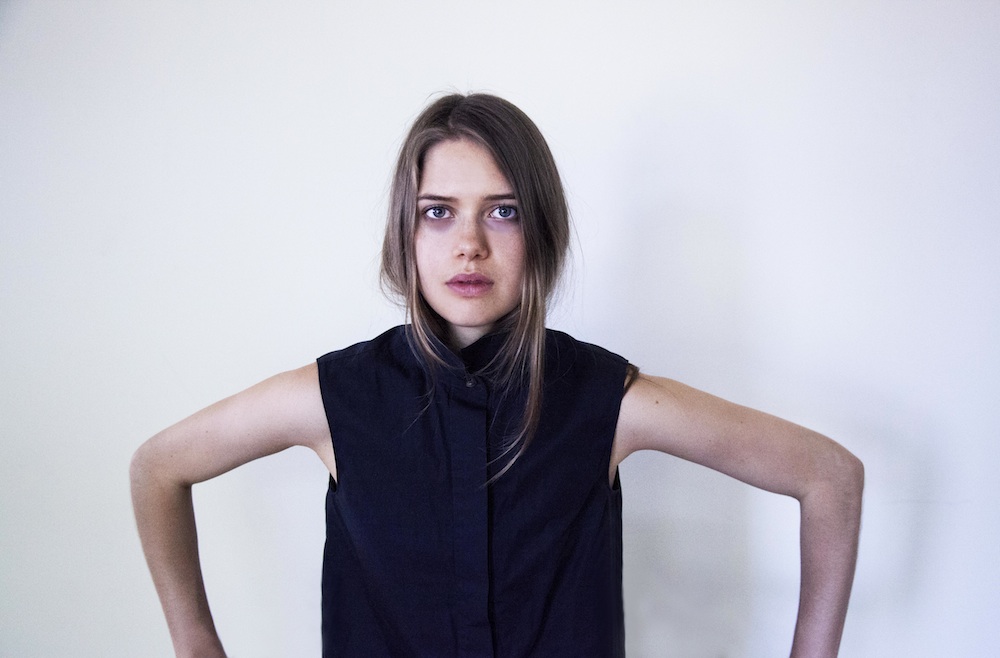
ABOVE: MORLY. PHOTO COURTESY OF GINA GAMMELL.
There’s a quote that’s been variously attributed to Frank Zappa, Elvis Costello, and Laurie Anderson, among others, that “writing about music is like dancing about architecture.” Something is lost in the translation between two media, yet something might also be gained. Likewise, a song’s lyrics often express something that the music alone can’t quite render. “I find that I usually have a feeling, just a feeling, and it makes a melody,” says singer/songwriter/producer Katy Morley, who records under the alias Morly. “But I won’t have lyrics for it until I understand the situation better.” This was the case for her most recent single, “The Choir,” the video for which is premiering below. Morly had begun to compose the track, but felt it was chronically lacking. “I was stuck, and I wasn’t sure what it needed,” she says. Then she pauses. “I have such a hard time talking about music.” At this point, we circle back to the Zappa-Costello-Anderson quote. “What it needed” came in the form of a fortuitous visit to a gospel choir to film a video for another song—the footage from which now composes the video for “The Choir,” as she scrapped the other video altogether.
“The Choir” is an enchanting display of restraint, an effort to reconcile Morly’s relationship to her music through her music. “Shirley calls for me to join in next to Fabra’s sweet tenor,” Morly sings, referring to women in the choir who inspired the track. “But I don’t see a place for me, and I’m too quiet to be heard.” Directed by long-time collaborator Gina Gammell, the moody video features sinewy choreography by rapper and dancer Briddy that complements the track’s minimalism.
Morly has finished her upcoming EP (slated for an April release), although it contrasts her previous work, she says, featuring “more lyrical, more traditional” music. Last summer’s In Defense of My Muse EP, weaves together a sonic tapestry of noise, with vocals playing a secondary role. (A breathy “ha-ha” introduces “Seraphese,” a track otherwise devoid of vocals, but grounded in the juxtaposition of delicate piano and the hum of a synthesizer.) “The Choir,” Morly’s first “singing song,” marks yet another right-turn for an artist who got her start being one part of the 22-member Minnesota-based project Gayngs, which counts the likes of Justin Vernon—alter ego Bon Iver—and Phil Cook of Megafaun.
We caught up with Morly by phone, when she was at her adopted home of Los Angeles just before jetting off for a spate of rehearsals in preparation for SXSW.
NAME: Katy Morley
AGE: 28
HOMETOWN: Minneapolis, Minnesota
EARLY EXPOSURE: I suppose I’d always written songs as a kid—just terrible little kid’s songs—but I didn’t really start producing until 2010. When I was a kid, my school had a really good musical program. We would always start on xylophone and recorder, but then I did four years of saxophone. I did jazz band in middle school and I was one of two girls. The boys were just relentless in teasing me, like, girls can’t play saxophone and those kind of things, and the teacher didn’t really do anything. I just couldn’t do it, so I switched over to choir. Then I started taking guitar, and, of course, started on piano as well—did, like, seven years of piano as a kid. A good smattering. I’m not a master in anything, which is great.
MUSICAL MEMORIES: Ultimately, I grew up on Bonnie Raitt, Fleetwood Mac, and I just love a good song. My dad is such a musical person. My oldest memory is dancing to MC Hammer with him, and we used to blast Phantom of the Opera and sing Phantom of the Opera together. My mom is a painter—she’s really artistic—but my dad is more the musical one.
AN EDUCATION: I went to college. I was a massive nerd, big academics girl my whole life. I decided to study neuroscience because it’s this completely unexplored field of the human mind. But I started working in the laboratory and realized I don’t have the constitution for lab work. I last-minute did painting as my major, neuroscience as my minor, and graduated college and just felt really depressed and didn’t know why. I realized it was because I wanted to make music and I was ignoring it because it didn’t seem like a possibility. No one in my family had ever made music. It seemed like this very far-fetched, irrational thing. I think it’s like Bob Dylan said—he felt like he was born very far away from where he was supposed to be. So I started just kind of making music in my bedroom and working in cafés and such and ended up singing on a friend’s project, which is called Gayngs. They needed one more female singer. No one knew I sang except for my best friend, who was dating one of the guys. I was terrified, but they liked what I did, so I got to be a part of that project. Meeting and befriending all of the musicians in Gayngs made me realize that it is very possible to have a career as a musician.
LOOKING FOR A SIGN: I was terrified of singing in front of people, but [Gayngs] had to perform at First Avenue, which is Minneapolis’s big club—it’s the club that broke Prince. I had to sing in front of 2,000 people and just get over that fear. It was only for one song. I got off stage and I was just so elated that I had done it and felt like I did a really good job. I started running back stage and I ran into Prince. He was just in the little hallway behind the stage, and he smiled at me so big and I just kind of stepped aside and let him pass. I think that if you’re ever looking for a sign, that felt like a sign. He’s this mythical figure—occasionally, there’s a rumor that Prince is in the club. He had a guitar strapped around him; he was going to play on stage with everyone. Then he just vanished in a cloud of purple smoke. He just disappeared.
FEVER DREAM: I think everyone thought I was a little confused [when I decided to do music]. I had mono, really bad mono, and I think everyone just thought I was a little sick and I’ll get my wits about me soon enough. Then, I think it turned into concern, because no one really wants to hear that their kid wants to be a professional artist. [My parents] were supportive, but definitely concerned for my financial security. I think I heard a lot of, “I kind of see you as a professor,” or, “You’re really good at science.” When I performed at First Ave., I think they both realized that I was pretty serious about it.
ART AND MUSIC: I’m not a synesthetic, but I definitely see things when I hear music—but not in any sort of narrative way. Studying painting, I just hated how political the art world was and music felt like this break from that, so making music was actually a way to take painting to a different medium. To paint with sound.
REALITY CHECK: I was living in Minneapolis in a very affordable house with my best friend and I was just working on getting better [from 2010 to 2014]. I was living in headphones trying to get better at producing—and writing songs, as well, but really just producing. People used to ask me how my stuff was, and I’d be like, “It’s okay.” They’d be like, “Get more confidence—you need to sell yourself.” But I felt it’s actually good to know when your stuff is bad and that will keep you working. When you’re first starting out it’s not going to be that good. It’s just not going to be. I think it’s helpful to know it’s bad but keep working with faith that it will get better as you do it more.
SOLO ACT: The traditional role of producer is very different from how people use that term. Traditionally, a producer helps an artist realize their vision. I’ve produced one other person, but mostly I only produce myself. I think it’s kind of evolved to mean an electronic beat-maker. I worked with this boy Seramic, and co-produced one of his songs. So I guess technically I am now a producer, since I’ve worked with someone other than myself. I’m just the type of person who wants to learn how to do everything myself. But also, when I was first starting out, it was really important for me to produce myself in order to find my own sound. Having an inside look into the music industry, I realized what a complete boys’ club it is. So I decided to learn production in part to opt out of the sexual politics that so many female musicians face. I also thought it was important in finding my own voice because I was very unsure about my sound and would have been quite malleable to whichever producer I worked with.
GENDER TROUBLE: When I first started putting out music, a lot of people assumed I was a guy. I got a fair amount of “sick remix bro” feedback. Because I’m so new to it all—and maybe also so independent—I haven’t experienced too many gender-based difficulties, aside from some surprise or doubt about my artistic and technical abilities. I’ve heard some pretty awful stories from more veteran ladies. It’s been really encouraging lately though because it seems like the industry is actively trying to combat its own sexism, like the response to Amber Coffman’s coming forward about being sexually harassed.
IN DEFENSE OF HER MUSE: I think all of my music has been a process of justifying making music, just because it’s taken me so long to convince myself that it’s okay to do this, and that my voice is worthwhile and it’s a valid thing for me to be spending my time doing. I think because it was such a foreign thing for me, it’s taken a while to realize this is my reality. I can be doing this for a career.
UP NEXT… After the EP, I suppose that elusive album. I have a pretty good idea of what I would want an album to sound like. I would also like to perform. I really like playing for people, so I would like to put together a nice band and play.
FOR MORE ON MORLY, VISIT HER FACEBOOK.

